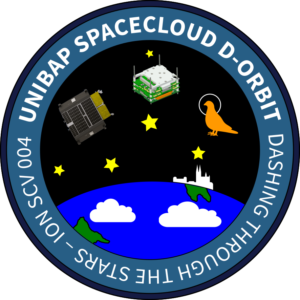Dashing Through The Stars Mission
On this mission, SpaceCloud hosts 17 evolved applications. In addition we now have verified uploading new applications while in-orbit.
Verifying over the air upgrades in Space
ION Satellite Carrier, D-Orbit’s Orbital Transportation Vehicle, was launched aboard a Falcon 9 rocket. SpaceX’s Transporter-3 mission on January 13th at 15:25 UTC (10:25 a.m. EST) from the Space Launch Complex 40 (SLC-40) at Cape Canaveral Space Force Station (CCSFS), Florida. On the same day, 1 hour 24 minutes 30 seconds minutes after liftoff, the ION vehicle was successfully deployed into a 500 km Sun synchronous orbit (SSO).

Unibap’s mission patch
We are working in collaboration with D-Orbit and the European Space Agency (ESA) supporting the in-orbit test of a hyperspectral electro-optical instrument developed by research institution VTT. The mission also consists of on-orbit testing of third-party payloads, including the second phase of testing of D-Orbit’s cloud platform designed to provide distributed high-performance data analytics computing and storage capabilities in space. This platform allows third parties to upload and execute cloud applications and AI workloads to process images as soon as they are created, allowing results to be sent to users in record time. The first test campaign, which took place during ION’s previous mission (WILD RIDE), successfully executed 23 separate SpaceCloud compatible applications from a variety of partners.
“We will experience apps that can provide near real time information about, for example, precision agriculture, natural disasters, traffic, or bush fires.”
– Mathias Persson, VP Space, Unibap
On this mission, SpaceCloud hosts 17 evolved applications, and we now can upload new applications while in-orbit. SpaceCloud is also connected to a hyperspectral electro-optical instrument developed by VTT. Having this sensor onboard gives commercial customer applications and third-party services access to satellite images in real-time directly in space.
What does this mean in terms of new commercial opportunities?
-This is a huge step forward in the multipurpose usage of satellites enabling new business models where anyone with an app can start charging for the time other actors use it. This improves the entire satellite business and enables a growing ecosystem of new platforms, vendors, and companies to join into space application development. In addition, the data processed on orbit translating into low latency usable information of higher value to the end users to be sent down to Earth. We will experience apps that can provide near real time information about, for example, precision agriculture, natural disasters, traffic, or bush fires, says Mathias Persson, VP Space, at Unibap.
If you want to read more about the Dashing Through the Stars Mission please refer to the mission booklet found on the mission page on D-Orbit’s webpage.